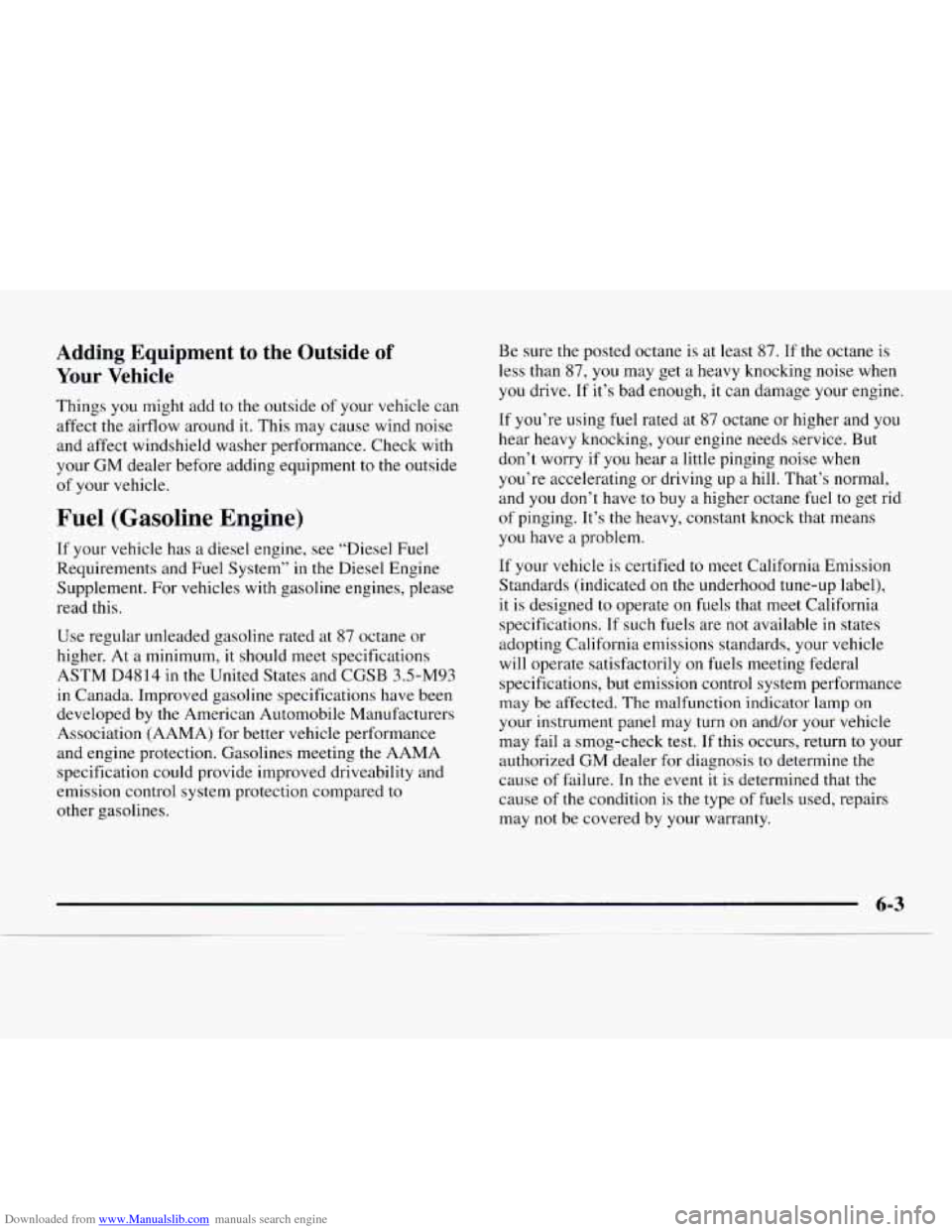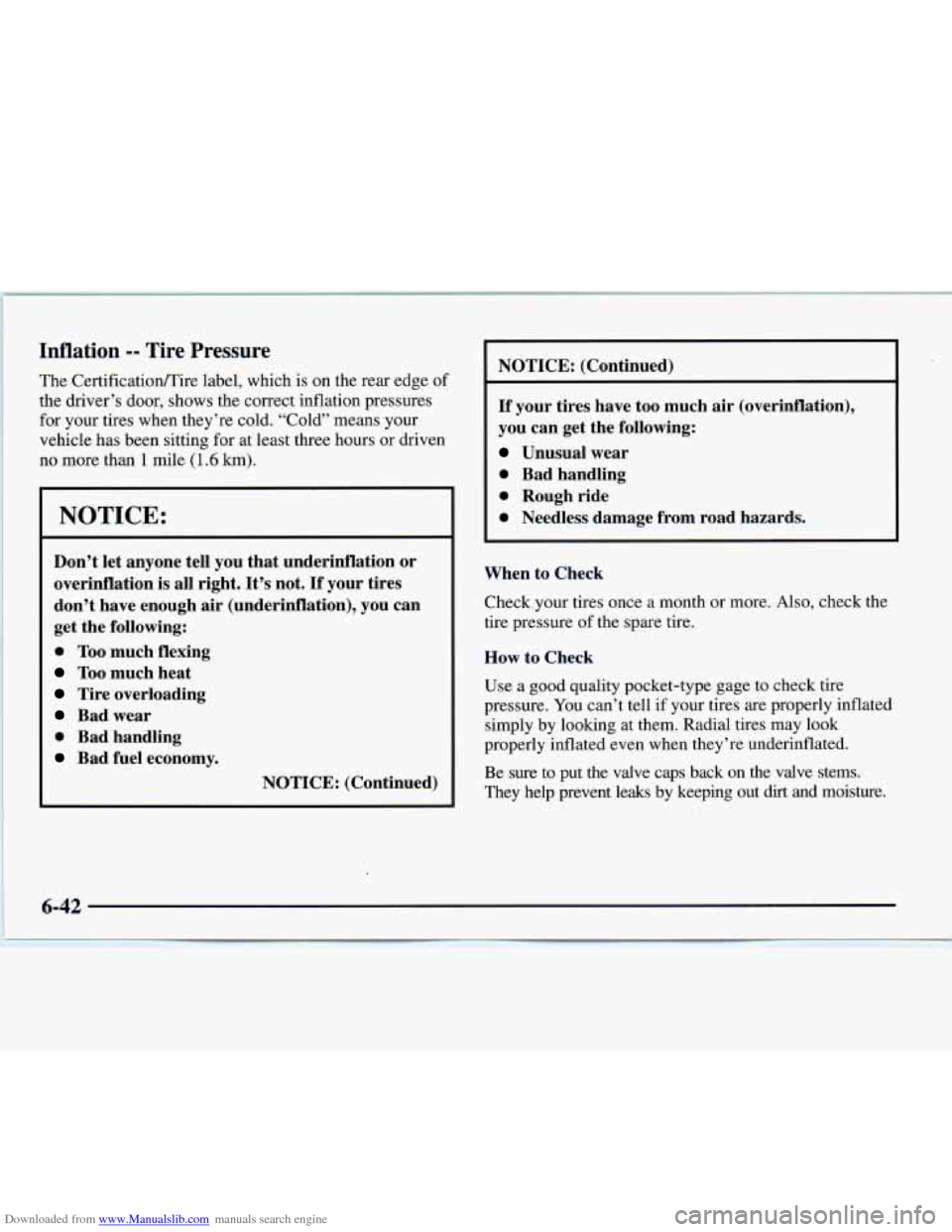Page 236 of 386

Downloaded from www.Manualslib.com manuals search engine Adding Equipment to the Outside of
Your Vehicle
Things you might add to the outside of your vehicle can
affect the airflow around it. This may cause wind noise
and affect windshield washer performance. Check with
your
GM dealer before adding equipment to the outside
of your vehicle.
Fuel (Gasoline Engine)
If your vehicle has a diesel engine, see “Diesel Fuel
Requirements and Fuel System” in the Diesel Engine
Supplement. For vehicles with gasoline engines, please
read this.
Use regular unleaded gasoline rated at 87 octane or
higher. At a minimum, it should meet specifications
ASTM
D48 14 in the United States and CGSB 3.5-M93
in Canada. Improved gasoline specifications have been
developed by the American Automobile Manufacturers
Association (AAMA) for better vehicle performance
and engine protection. Gasolines meeting the AAMA
specification could provide improved driveability and
emission control system protection compared to
other gasolines. Be
sure the posted octane is at least 87. If the octane
is
less than 87, you may get a heavy knocking noise when
you drive. If it’s bad enough, it can damage your engine.
If you’re using fuel rated at 87 octane or higher and you
hear heavy knocking, your engine needs service.
But
don’t worry if you hear a little pinging noise when
you’re accelerating or driving up a hill. That’s normal,
and
you don’t have to buy a higher octane fuel to get rid
of pinging. It’s the heavy, constant knock that means
you have a problem.
If your vehicle is certified to meet California Emission
Standards (indicated on the underhood tune-up label),
it
is designed to operate on fuels that meet California
specifications.
If such fuels are not available in states
adopting California emissions standards, your vehicle
will operate satisfactorily on fuels meeting federal
specifications, but emission control system performance
may be affected. The malfunction indicator lamp on
your instrument panel may turn on and/or your vehicle
may fail a smog-check test. If this occurs, return to your
authorized
GM dealer for diagnosis to determine the
cause of failure.
In the event it is determined that the
cause of the condition is the type
of fuels used, repairs
may not be covered by your warranty.
Page 240 of 386
Downloaded from www.Manualslib.com manuals search engine When you put the cap back on, turn it to the right
(clockwise) until you hear
a clicking sound. Make sure
you fully install the cap.
NOTICE:
If you need a new cap, be sure to get the right
type. Your dealer can get one for you. If you get
the wrong type, it may not fit
or have proper
venting, and your fuel tank and emissions system
might be damaged.
Checking Things Under the Hood
To open the hood, first
pull this handle inside the
vehicle.
It is just in front of
the driver’s side door frame
near the floor.
Page 275 of 386

Downloaded from www.Manualslib.com manuals search engine Inflation -- Tire Pressure
The CertificatiodTire label, which is on the rear edge of
the driver’s door, shows the correct inflation pressures
for your tires when they’re cold.
“Cold” means your
vehicle has been sitting for at least three hours or driven
no more than
1 mile (1.6 lun).
NOTICE:
Don’t let anyone tell you that underinflation or
overinflation is all right. It’s not.
If your tires
don’t have enough air (underinflation), you can
get the following:
0 Too much flexing
Too much heat
Tire overloading
Bad wear
0 Bad handling
Bad fuel economy.
NOTICE: (Continued) NOTICE:
(Continued)
If your tires have too much air (overinflation),
you can get the following:
Unusual wear
0 Bad handling
0 Rough ride
0 Needless damage from road hazards.
When to Check
Check.your tires once a month or more. Also, check the
tire pressure of the spare tire.
How to Check
Use a good quality pocket-type gage to check tire
pressure. You can’t tell if your tires are properly inflated
simply by looking at them. Radial tires may look
properly inflated even when they’re underinflated.
Be
sure to put the valve caps back on the valve stems.
They help prevent leaks by keeping out
dirt and moisture.
6-42
Page 298 of 386
Downloaded from www.Manualslib.com manuals search engine Engine Identification -- Gasoline Engines
Type V6 V8 Engine
“VORTEC”4300 “VORTEC”5000
VIN Code W M
Fuel System CSFI~ CSFI 1
Central Sequential Fuel
Injection
2Sequential Fuel Injection
Wheel Nut Torque
MODEL
All
TORQUE
140 ft-lb (1 90 N-m)
Cooling System Capacity
ENGINE VIN
“VORTEC”4300 W
“VORTEC”5000 M
“VORTEC”5700 R
“VORTEC”7400 J
“VORTEC”5700
V8
R
CSFI 1
“VORTEC”7400
V8
J
SFI*
QTY Without Rear Heater*
1 1 Quarts (10.4 L)
17 Quarts ( 16 L)
17 Quarts ( 16 L)
23 Quarts (21.8 L)
QTY With Rear Heater*
14 Quarts (13.2 L)
20 Quarts (18.9 L)
20 Quarts (18.9 L)
26 Quarts (24.6 L)
After refill, the level MUST be checked as outlined under “Engine Cooling System” in Section 5.
*All quantities are approximate.
Page 299 of 386
Downloaded from www.Manualslib.com manuals search engine Crankcase Capacity
ENGINE VIN Quantity With Filter
“VORTEC”4300 W 4.5 Quarts (4.3 L)
“VORTEC”5000 M 5 Quarts (4.8 L)
“VORTEC”5700 R 5 Quarts (4.8 L)
“VORTEC”7400 J 7 Quarts (6.5 L)
All quantities are approximate.
After refill, the level
MUST be checked as outlined
under “Engine Oil And Filter Recommendations”
in
Section 5.
**Add one additional quart for RPO 5Zl and
RPO KL5 Models.
Fuel Tank Capacity
TYPE QUANTITY
Standard Tank 31 Gallons (117.33 L)
Optional Tank** 55 Gallons (208.18 L)
*All quantities are approximate.
** 159” , 177” Wheelbase Vehicles Only.
Page 300 of 386

Downloaded from www.Manualslib.com manuals search engine Normal Replacement Parts
Engine VIN
Oil Filter
Air Cleaner Filter*
PCV Valve
Spark Plugs
Fuel Filter
Radiator Cap
*Replace with AC Ai
“VORTEC”4300
w
PF52
A9 17C
CV789C
41-932 GF48
1
RC36
“VORTEC”5000
r Filter, Part No. A917C and fi
Air Conditioning Refrigerant Capacity
M
PF1218
A917C
cv774c
4 1-932 GF48
1
RC36
or severe dua
NOTICE:
R-134A refrigerant is not compatible with R-12
refrigerant in an air conditioning system. R-12 in
an R-134A system
will cause compressor failure,
refrigerant oil sludge, or poor air conditioning
system performance. “VORTEC”5700
R
PF1218
A9 17C
cv774c
4 1-932
GF48
1
RC36
“VORTEC”7400
J
PF1218
A917C
cv774c
41-932 GF48
1
RC36
;ty conditions, use, AC Air Filter, Part No. 1236C.
TYPE QTY Front Only QTY Front and Rear
Refrigerant 3.00 Ibs. (1.36 kg) 4.875 Ibs. (2.2 1 kg)
R- 134A
Air Conditioning Refrigerants
Not all air conditioning refrigerants are the same.
If the air conditioning system in your vehicle needs
refrigerant,
be sure the proper refrigerant is used.
Tf you’re not sure, ask your GM dealer.